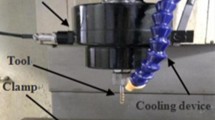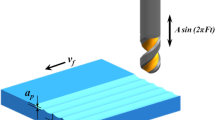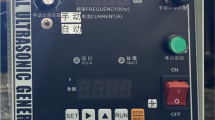Abstract
Micromilling (MM) is favored by the field of high-precision micro parts. However, the high plasticity of Inconel718 often poses a threat to MM, such as pits, humps, and gullies, which affect the surface quality. In this study, the influence of ultrasonic vibration-assisted micromilling (UVAMM) on surface quality is comprehensively analyzed by using the machining process of workpiece vibration, combined with cutting force, tool wear, surface texture, and corrosion resistance. The results show that small amplitude plays a significant role in reducing cutting force and inhibiting tool wear. The better surface quality is obtained by optimizing cutting parameters (the cutting speed (vc) is 37.68 m/min, the feed per tooth (ƒz) is 3 μm/z, and the amplitude (A) is 6 μm), which is a uniform and regular fish scale surface with lower surface roughness and fewer surface defects. Furthermore, the application of ultrasonic vibration also significantly improves the surface corrosion resistance of Inconel718. It is worth noting that the surface corrosion resistance does not completely depend on the surface roughness, but also has a close correlation with the surface texture.






















Similar content being viewed by others
References
Aurich JC, Reichenbach IG, Schüler GM (2012) Manufacture and application of ultra-small micro end mills. CIRP Ann - Manuf Technol 61(1):83–86. https://doi.org/10.1016/j.cirp.2012.03.012
Atif M, Munish KG, Tadeusz M, Yurievich PD, Khaled G (2021) Effect of tool coating and cutting parameters on surface roughness and burr formation during micromilling of Inconel 718. Metals 11(1):1–18. https://doi.org/10.3390/MET11010167
Milan B, Andrea DB, Ekrem O, Alborz S, Dirk B (2020) Experimental and computational investigations on the effects of deep-temperature emulsion on the turning of Inconel 718 alloy. CIRP J Manuf Sci Tec 31:48–60. https://doi.org/10.1016/j.cirpj.2020.10.001
Wang W, Kweon SH, Yang SH (2005) A study on roughness of the micro-end-milled surface produced by a miniatured machine tool. J Mater Process Technol 162–163:702–708. https://doi.org/10.1016/j.jmatprotec.2005.02.141
Lu XH, Jia ZY, Wang H, Feng YX, Liang SY (2019) The effect of cutting parameters on micro-hardness and the prediction of Vickers hardness based on a response surface methodology for micro-milling Inconel 718. Measurement 140:56–62. https://doi.org/10.1016/j.measurement.2019.03.037
Mian AJ, Driver N, Mativenga PT (2011) Identification of factors that dominate size effect in micro-machining. Int J Mach Tool Manuf 51(5):383–394. https://doi.org/10.1016/j.ijmachtools.2011.01.004
Oliveira DD, Gomes MC, Silva MB (2020) Influence of cutting fluid application frequency on the surface quality of micromilled slots on Inconel 718 alloy. Procedia Manuf 48:553–558. https://doi.org/10.1016/j.promfg.2020.05.082
Ucun İ, Aslantaş K, Bedir F (2015) The effect of minimum quantity lubrication and cryogenic pre-cooling on cutting performance in the micro milling of Inconel 718. P I Mech Eng B-J Eng 229(12):2134–2143. https://doi.org/10.1177/0954405414546144
Evgeny B, Hughes T, Eskin D (2016) Effect of surface roughness on corrosion behaviour of low carbon steel in inhibited 4 M hydrochloric acid under laminar and turbulent flow conditions. Corros Sci 103:196–205. https://doi.org/10.1016/j.corsci.2015.11.019
Alvarez RB, Martin HJ, Horstemeyer MF, Chandler MQ, Williams N, Wang PT, Ruiz A (2010) Corrosion relationships as a function of time and surface roughness on a structural AE44 magnesium alloy. Corros Sci 52(5):1635–1648. https://doi.org/10.1016/j.corsci.2010.01.018
Uddin MS, Rosman H, Hall C, Murphy P (2017) Enhancing the corrosion resistance of biodegradable Mg-based alloy by machining-induced surface integrity: influence of machining parameters on surface roughness and hardness. Int J Adv Manuf Technol 90(5–8):5095–5108. https://doi.org/10.1007/s00170-016-9536-x
Shen XH, Zhang JH, Yin TJ, Dong CJ (2010) A study on cutting force in micro end milling with ultrasonic vibration. Adv Mater Res 905(198):1910–1914. https://doi.org/10.4028/www.scientific.net/AMR.97-101.1910
Shen XH, Wang MY (2016) Finite element analysis of temperature field in vibration milling. Key Eng Mater 693:1030–1037. https://doi.org/10.4028/www.scientific.net/KEM.693.1030
Chen G, Ren CZ, Zou YH, Qin XD, Lu LP, Li SP (2019) Mechanism for material removal in ultrasonic vibration helical milling of Ti6Al4V alloy. Int J Mach Tool Manuf 138:1–13. https://doi.org/10.1016/j.ijmachtools.2018.11.001
Ni CB, Zhu LD, Yang ZC (2019) Comparative investigation of tool wear mechanism and corresponding machined surface characterization in feed-direction ultrasonic vibration assisted milling of Ti-6Al-4V from dynamic view. Wear 436–437:1–17. https://doi.org/10.1016/j.wear.2019.203006
Gong H, Fang FZ, Hu XT (2009) Kinematic view of tool life in rotary ultrasonic side milling of hard and brittle materials. Int J Mach Tool Manuf 50(3):303–307. https://doi.org/10.1016/j.ijmachtools.2009.12.006
Sajjady SA, Abadi HN, Amini S, Nosouhi R (2016) Analytical and experimental study of topography of surface texture in ultrasonic vibration assisted turning. Mater Des 93:311–323. https://doi.org/10.1016/j.matdes.2015.12.119
Tao GC, Ma C, Bai LY, Shen XH, Zhang JH (2017) Feed-direction ultrasonic vibration-assisted milling surface texture formation. Mater Manuf Process 32(2):193–198. https://doi.org/10.1080/10426914.2016.1198029
Zhang ML, Zhang DY, Geng DX, Shao ZY, Liu YH, Jiang XG (2019) Effects of tool vibration on surface integrity in rotary ultrasonic elliptical end milling of Ti-6Al-4V. J Alloy Compd 821:1–10. https://doi.org/10.1016/j.jallcom.2019.153266
Biermann D, Kersting P, Surmann T (2010) A general approach to simulating workpiece vibrations during five-axis milling of turbine blades. CIRP Ann - Manuf Technol 59(1):125–128. https://doi.org/10.1016/j.cirp.2010.03.057
Lu H, Zhu LD, Yang ZC, Yan BL, Hao YP, Qin SQ (2021) Research on the generation mechanism and interference of surface texture in ultrasonic vibration assisted milling. Int J Mech Sci 208:1–18. https://doi.org/10.1016/J.IJMECSCI.2021.106681
Hsu CY, Huang CK, Wu CY (2007) Milling of MAR-M247 nickel-based superalloy with high temperature and ultrasonic aiding. Int J Adv Manuf Technol 34(9–10):857–866. https://doi.org/10.1007/s00170-006-0657-5
Suárez A, Veiga F, Lacalle LN, Polvorosa R, Lutze S, Wretland A (2016) Effects of ultrasonics-assisted face milling on surface integrity and fatigue life of Ni-Alloy 718. J Mater Eng Perform 25(11):5076–5086. https://doi.org/10.1007/s11665-016-2343-6
Wang Z, Kovvuri V, Araujo A, Bacci M, Hung WN, Bukkapatnam ST (2016) Built-up-edge effects on surface deterioration in micromilling processes. J Manuf Process 24:321–327. https://doi.org/10.1016/j.jmapro.2016.03.016
Thiele JD, Melkote SN (1999) Effect of cutting edge geometry and workpiece hardness on surface generation in the finish hard turning of AISI 52100 steel. J Mater Process Technol 94:216–226. https://doi.org/10.1016/S0924-0136(99)00111-9
Zhu LD, Ni CB, Yang ZC, Liu CF (2019) Investigations of micro-textured surface generation mechanism and tribological properties in ultrasonic vibration-assisted milling of Ti–6Al–4V. Precis Eng 57:229–243. https://doi.org/10.1016/j.precisioneng.2019.04.010
Cheng YN, Xu M, Guan R, Liu L, Qian J (2017) Generation mechanism of insert residual stress while cutting 508III steel. Int J Adv Manuf Technol 91(1–4):247–255. https://doi.org/10.1007/s00170-016-9724-8
Saoubi RM, Outeiro JC, Chandrasekaran H, Dillon OW Jr, Jawahir IS (2008) A review of surface integrity in machining and its impact on functional performance and life of machined products. Int J Sus Manuf 1(1–2):203–236. https://doi.org/10.1504/IJSM.2008.019234
Zuo Y, Wang HT, Xiong JP (2002) The aspect ratio of surface grooves and metastable pitting of stainless steel. Corros Sci 44(1):25–35. https://doi.org/10.1016/S0010-938X(01)00039-7
Huang J, Li Z, Liaw BY, Zhang JB (2016) Graphical analysis of electrochemical impedance spectroscopy data in Bode and Nyquist representations. J Power Sources 309:82–98. https://doi.org/10.1016/j.jpowsour.2016.01.073
Funding
This research was supported by the National Natural Science Foundation of China (52075275), Agricultural Key Applied Project of China (SD2019NJ015), Chuzhou Science and Technology Bureau Foundation of China (2020ZG004), and Tongling Science and Technology Bureau Foundation of China (20200101005).
Author information
Authors and Affiliations
Corresponding author
Ethics declarations
Ethics approval
Not applicable.
Consent to participate
Not applicable.
Consent for publication
Not applicable.
Competing interests
The authors declare no competing interests.
Additional information
Publisher's note
Springer Nature remains neutral with regard to jurisdictional claims in published maps and institutional affiliations.
Rights and permissions
About this article
Cite this article
Yuan, Z., Fang, B., Dong, Y. et al. Study on surface texture and corrosion resistance of ultrasonic vibration-assisted micromilling Inconel718. Int J Adv Manuf Technol 121, 601–618 (2022). https://doi.org/10.1007/s00170-022-09292-z
Received:
Accepted:
Published:
Issue Date:
DOI: https://doi.org/10.1007/s00170-022-09292-z




